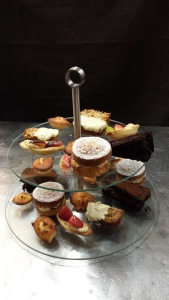Not to mention chutney.
I’m bored with being ill, let’s talk about nice things.
It’s that time of year again, preserving and storing the yummy things of summer to be enjoyed in the dark, cold days of winter. Every year I promise myself I will be adventurous and make loads of different things and while I do manage a few novelties, every year the same three staples come out of my kitchen, bramble jelly, apple butter and apple chutney.
My recipe or rather method, for bramble jelly is on here somewhere. Nothing really changes from year to year, blackberries are still a wonderful natural and free food and they’re still vicious bastards. Every year I try a new, thicker pair of gloves and every year I end up dripping blood, scratched to ribbons and stained purple in unlikely places.
The only change I have made is I now put them in a plastic box with a sealed lid for a few hours after I’ve picked them. It is remarkable how many creepy crawlies emerge and pin themselves to the lid looking for an escape route and nothing puts you off a clotted cream and bramble jelly scone more than the presence of something leggy embedded in the sweet purple yumminess..
Apple butter and apple chutney are going to be a bit more of a problem this year. Ever since we moved into this house the apple tree in the garden that backs on to us has hung its unpruned branches over our wall and dropped piles and piles of wind falls into our lawn and every year I gather them up, cut out the bruises and the bugs and turn them into apple butter and chutney,
This year the behind neighbours have FELLED my apple tree!!! Okay, it was their tree, it was rotten and it was trying to bring down the wall, but that is not the point, where am I going to get free apples now? I’m trying not to mutter and I’ve started training binoculars on other neighbours gardens. I think I’ve spotted a tree a couple of doors down. so the time may have come to take an offering of cake there…just to be friendly you unbderstand,
There are as many recipes for apple butter on the web as there are apples on a tree. Find one you like and give it a go, its a great resource, it can be eaten on bread like jam, made into a pie or even eaten as it comes with cream or poured over ice cream. I once served it at a posh dinner party with vanilla ice cream and cinnamon shortbread biscuits, I could say it wasn’t a triumph, but I’d be lying.
Apple chutney is also not something I can give you a recipe for, because it varies every time I make it depending on what sugar is in the larder, what vinegar (I avoid malt) and what dried fruit and spices are left over. Cook chopped apple in vinegar and sugar adding what you like, chilli, allspice, cinnamon, cloves…the spicy world in your oyster and your choice of dried fruit. Last year I used white wine vinegar, soft light brown sugar, dried figs and apricots and allspice. You cook it until a wooden spoon dragged across the bottom of the pan leaves a clean line and then pot it. Do NOT be tempted to try it, it will taste harsh and you will want to cry, but if you leave it for a couple of months it will mellow and mature into a gorgeous product that goes wonderfully with cheese, ham and pork.
Don’t waste what the sun and the good earth have provided, preserve it, but always leave some for the birds and the animals who will need it to survive the lean times that are now just around the corner.

![chocolate-1961599_960_720[1]](https://kentishmaid.files.wordpress.com/2017/09/chocolate-1961599_960_7201.jpg?w=584)







You must be logged in to post a comment.